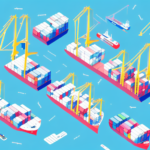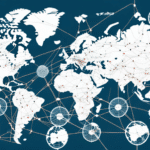Exploring the Benefits of Free Trade Agreements (FTAs) for Supply Chain Management
If you are a supply chain professional or a business owner, you are likely familiar with the challenges of managing international trade. Globalization has opened up new markets and opportunities, but it has also increased complexities in supply chain operations. One of the biggest obstacles is navigating different trade regulations and local laws that companies must comply with. This is where Free Trade Agreements (FTAs) emerge as a game-changer in global supply chain management.
Understanding Free Trade Agreements (FTAs) and Their Impact on Supply Chain Management
FTAs are treaties between countries designed to promote free trade by eliminating or reducing tariffs, quotas, and other trade barriers on specific goods and services. This facilitates smoother and more cost-effective exchanges between signatory countries, making products more competitive in the global market.
For supply chain professionals, FTAs simplify the import and export processes. Companies can import raw materials or finished products at lower costs, leading to significant cost savings and a competitive edge. Moreover, FTAs create a level playing field, fostering fair competition and preventing market monopolization by larger companies.
Additionally, FTAs encourage foreign investment by signaling a commitment to free trade and open markets. This attraction of foreign companies can lead to job creation and economic growth in the signatory countries.
However, FTAs can also pose challenges. For instance, companies heavily reliant on imports from non-FTA countries may face higher tariffs and trade barriers, increasing costs and reducing competitiveness. Furthermore, increased competition resulting from FTAs can pressure companies to lower prices and reduce profit margins.
FTAs: A Game-Changer in Global Supply Chain Management
With the rise of globalization and e-commerce, supply chain management has become more complex. Managing cross-border trade regulations is a daunting task, but FTAs simplify this by reducing the need to navigate different regulations for each country. This can lead to significant savings in time, resources, and costs.
Another advantage of FTAs is market expansion. By removing high tariffs and trade barriers, businesses can access previously unreachable markets, driving increased sales and revenue. FTAs also promote foreign investment and joint ventures, allowing companies to collaborate with international partners without excessive taxes or regulations.
Furthermore, FTAs can enhance product and service quality. Access to a broader range of inputs and resources enables companies to improve their production processes, resulting in higher-quality products that boost customer satisfaction and loyalty.
Environmental benefits also arise from FTAs. By reducing trade barriers and fostering international cooperation, FTAs encourage the adoption of sustainable practices and technologies, helping to lower carbon emissions and conserve natural resources.
A Closer Look at How FTAs Simplify Supply Chain Management Processes
FTAs streamline the import and export processes by minimizing paperwork and documentation. For example, companies can use a single Certificate of Origin for all FTA countries, eliminating the need for multiple forms and certifications.
Additionally, FTAs promote regulatory cooperation among signatory countries, leading to the harmonization of standards and regulations. This reduces discrepancies and enhances supply chain efficiency, allowing companies to focus on delivering quality products rather than managing regulatory compliance.
Intellectual property protection is another critical provision often included in FTAs. This ensures that companies can safeguard their patents, trademarks, and copyrights when operating in FTA countries, which is vital for industries like pharmaceuticals, software, and entertainment.
Lastly, by reducing tariffs and trade barriers, FTAs lower costs associated with international trade. This makes it easier for small and medium-sized enterprises (SMEs) to compete in the global market, driving increased sales and profitability.
How FTAs Reduce Trade Barriers and Enhance Supply Chain Efficiency
- Tariff and Quota Elimination: FTAs remove tariffs and quotas, decreasing the cost of trade and making products more competitive.
- Non-Tariff Barriers Reduction: These agreements also lower non-tariff barriers like technical regulations and licensing requirements, opening up new markets.
- Efficient Resource Allocation: By enabling companies to source inputs from the most cost-effective countries, FTAs optimize resource allocation and improve supply chain efficiency.
- Encouraging Innovation: Increased competition from FTAs drives companies to innovate and differentiate their products and services.
According to the Office of the United States Trade Representative, countries participating in FTAs experience a significant boost in trade volume, which enhances overall economic growth and stability.
Impact of FTAs on Inventory Management and Cost Savings in Supply Chains
Effective inventory management is crucial for supply chain efficiency. FTAs facilitate easier sourcing of inputs from various countries at lower costs, allowing companies to reduce inventory levels and associated storage costs. This minimizes the risk of stock-outs and ensures a more responsive supply chain.
Cost reductions resulting from FTAs enable businesses to offer competitive pricing, driving increased sales and revenue. These savings can be reinvested into research and development, fostering further innovation and product improvement.
Moreover, by expanding market access, FTAs help businesses reach new customer bases, leading to higher demand and economies of scale. This not only boosts sales but also enhances cost-efficiency across the supply chain.
Leveraging the Benefits of FTAs to Reduce Transportation Costs in Supply Chains
Transportation is a significant expense in supply chains. FTAs help reduce these costs by allowing businesses to access new markets more affordably and source inputs from a wider range of suppliers. This increased access can lead to better-negotiated transportation rates.
Additionally, FTAs often spur the development of infrastructure and logistics services, resulting in more efficient transportation networks that lower delivery times and costs. The integration of new technologies, such as digital platforms and automation, further optimizes transportation and logistics operations.
For example, the ShipScience case studies highlight how companies have successfully reduced transportation costs by leveraging FTAs.
The Role of Technology in Maximizing the Benefits of FTAs for Supply Chain Management
Technology is pivotal in enhancing supply chain management under FTAs. Electronic documentation and digital platforms streamline FTA-related procedures, saving time and resources while improving collaboration across departments and stakeholders.
Data analytics and simulation tools enable companies to optimize supply chain operations and identify opportunities to leverage FTAs effectively. For instance, simulation tools can model the impact of an FTA on supply chain networks, helping companies determine the best configurations.
Technologies like RFID and GPS enhance supply chain visibility and traceability, allowing real-time tracking of goods. This ensures compliance with FTA regulations related to product origin and traceability, improving operational efficiency.
Moreover, online portals and messaging platforms facilitate better communication and coordination with suppliers and customers, reducing lead times and enhancing overall supply chain responsiveness.
Case Studies: Successful Implementation of FTA-Based Supply Chain Strategies by Companies
Many companies have successfully leveraged FTAs to optimize their supply chains:
- BMW: Utilizing the North American Free Trade Agreement (NAFTA), BMW streamlined its supply chain by sourcing parts from multiple countries and assembling vehicles in Mexico. This strategy minimized supply chain disruptions and enhanced competitiveness.
- Samsung: Through the Korea-US FTA, Samsung increased its market share in the US by accessing new markets and reducing trade costs, leading to significant sales growth.
The Future of FTA-Based Supply Chain Management: Trends and Opportunities
The future of FTA-based supply chain management looks promising as more countries continue to sign FTAs and collaborate on free trade initiatives. Emerging trends such as digital trade and e-commerce present new opportunities for companies to expand their global reach and access untapped markets.
Businesses should remain informed about the latest developments in FTAs and proactively identify ways to leverage these agreements to strengthen their supply chains. By adopting forward-thinking strategies, companies can achieve substantial cost savings, enhance competitiveness, and position themselves for sustained growth in the global market.
For the latest insights and updates on FTAs, visit the ShipScience blog.






















